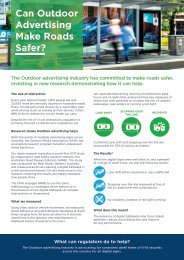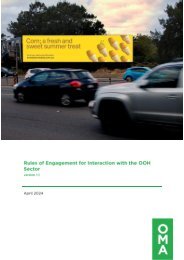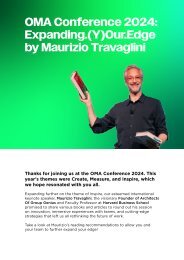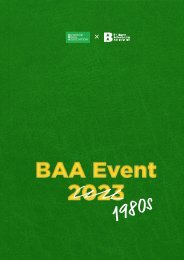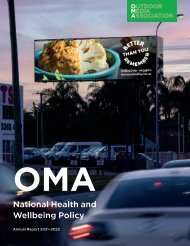OPEN 2
The OPEN series was born from the desire to create a forum for applauding and interrogating strong creative design within the Out of Home (OOH) industry. Illustrating how OOH is part of our cityscape, our commute, our weekend and our shopping and holiday experiences, OOH is ‘the original tweet’ and it cannot be switched off, ignored or fast forwarded. Big, bold, cheeky, simple, clever and controversial, OOH is the ultimate creative stage, allowing brands to be unique, contextually relevant and targeted while reaching mass audiences.
The OPEN series was born from the desire to create a forum for applauding and interrogating strong creative design within the Out of Home (OOH) industry. Illustrating how OOH is part of our cityscape, our commute, our weekend and our shopping and holiday experiences, OOH is ‘the original tweet’ and it cannot be switched off, ignored or fast forwarded. Big, bold, cheeky, simple, clever and controversial, OOH is the ultimate creative stage, allowing brands to be unique, contextually relevant and targeted while reaching mass audiences.
Create successful ePaper yourself
Turn your PDF publications into a flip-book with our unique Google optimized e-Paper software.
HUMOUR ME<br />
Jane Caro, Writer, Lecturer<br />
and Media Commentator<br />
...<br />
The most important – and also the most<br />
neglected – part of persuasive communication<br />
is that it must contain something unexpected.<br />
This is the element that causes us to stop and<br />
pay attention. It disturbs the usual and shakes<br />
us out of our torpor. It is also the part of<br />
a communication that those who commission<br />
such things are most afraid.<br />
When I worked in ad agency creative<br />
departments, we often joked at how unerringly<br />
many clients would find the idea in an<br />
advertisement and demand it be taken out.<br />
That’s because the idea – in an advertising<br />
creative person’s terms – is the part of the<br />
concept that makes it unexpected, different,<br />
and, yes, a little bit disturbing. Sadly, without<br />
an element of the unexpected, messages sink<br />
without a trace. However deep your pockets,<br />
it is no longer possible to bore people into<br />
buying your product. These days, they will<br />
either physically reject your message by fastforwarding<br />
it, muting it, skipping it or – if all<br />
that fails – by simply ignoring it. We’ve never<br />
been so besieged by advertising messages and<br />
never been so less likely to notice them.<br />
Some advertisements, however, are<br />
transcending the technology to such an<br />
extent that they are becoming destinations in<br />
themselves. Their creators have realised that<br />
if you make the message relevant, compelling<br />
and engaging enough, your audience will<br />
also become your media. They will post your<br />
message on their Facebook page and tweet it to<br />
their followers. If they do that, discussions will<br />
emerge around your message and it will become<br />
not an intruder on the popular conversation (as<br />
so many advertisements still are) but both an<br />
instigator and an equal participant. That’s the<br />
Holy Grail for any message.<br />
For Out-of-Home (OOH) advertising<br />
messages, however, the pursuit of the<br />
unexpected in cynical, lazy or unskilled hands,<br />
has the potential to cause real problems.<br />
OOH messages have always had the<br />
advantage of being harder to ignore. They<br />
are able to intrude themselves into our<br />
field of vision simply by being a part of the<br />
landscape. You can’t even go to a public loo<br />
these days without someone sticking an<br />
advertising message on the back of the door!<br />
This is also their disadvantage. Because<br />
OOH advertisements cannot be avoided by<br />
passers-by, there is an added responsibility<br />
on advertisers in terms of their message. The<br />
advertisement that might be unexceptional<br />
in Zoo magazine, for example, is going to cause<br />
trouble 24 sheets high beside the M1. I spend<br />
quite a lot of my time as a media commentator<br />
apologising on the advertising industry’s behalf<br />
for ill-conceived posters.<br />
Part of the problem is a lazy attempt<br />
to gain attention via shock. There is nothing<br />
intrinsically wrong with shock as a way<br />
to include the unexpected in your message –<br />
just as long as the unexpected is relevant and<br />
appropriate. When it is borrowed interest,<br />
however, or just a cynical attempt to cause<br />
a furore and so gain free exposure, it may<br />
work in the short term but, in the long term,<br />
it increases pressure for creativity to be limited<br />
by legislation, which will damage us all.<br />
Advertisers, like any other participant<br />
in the public space, have two sets of<br />
responsibilities – to their client and to<br />
society as a whole. Yet, to get noticed, OOH<br />
advertisements still have to disturb the usual<br />
by doing something unexpected. The task is<br />
a tough one, but if you get it right, the rewards<br />
can be worth it.<br />
Create a message that disturbs your<br />
audience in a positive way and you can spend<br />
far less of your budget on buying media and far<br />
more on making a really first-rate message<br />
– be it for television, OOH, print, online or<br />
45 /



